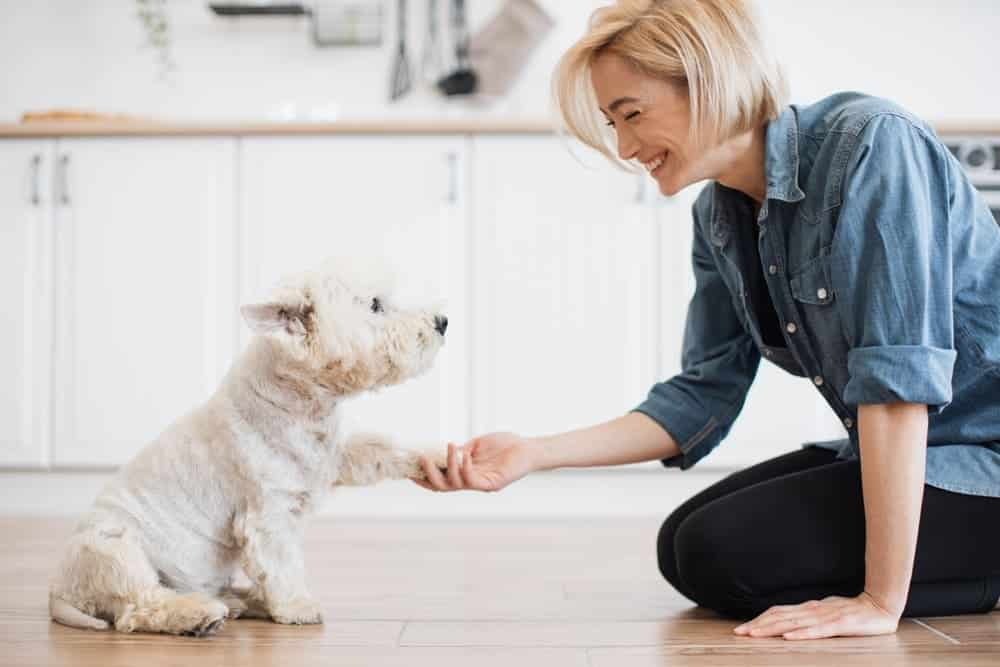Some terms that describe positive reinforcement dog training include clicker, force-free, positive, and even science-based dog training.
Specific terminology is associated with a broader philosophy of dog training in addition to a particular technique, and those philosophical and ethical considerations are significant.
However, the word “positive reinforcement” has a precise definition and is also technical. So, here, let’s learn about positive reinforcement in dog training.
What Is Positive Reinforcement in Dog Training?
Dog training is greatly aided by positive reinforcement. Adding something immediately following behaviour to increase frequency is known as favourable reinforcement.
In technical terms, the phrase consists of two parts. When a behaviour is reinforced, it either persists or becomes more frequent. Positive denotes the addition of something.
You may have heard “positive reinforcement training ” and various explanations. The phrase has two definitions: It’s a procedure that aids in the acquisition of new abilities by dogs and all pets and also distinguishes a class of trainers that focus primarily on positive reinforcement training.
Compared to alternative approaches, positive reinforcement teaching preserves pets’ behavioural well-being, strengthens behaviour, and fosters trustworthy relationships between pet parents and their animal partners.
Reinforcement is the process of making a behaviour stronger. There are two types of reinforcement: positive and negative.
Why Use Positive Reinforcement?
On the other hand, some dogs have been known to react aggressively when punishment is applied, and using unpleasant methods increases the likelihood of hostility against family members and those outside the home.
Even though these studies are correlational and cannot establish causation, several factors could be at play. One is that, unlike penalizing your dogs for a behaviour, positive reinforcement teaches your dogs what to do.
On the other hand, some dogs have been known to react aggressively when punishment is applied, and using aversive methods increases the likelihood of hostility toward family members and people outside the household.
Even though these studies are correlational and cannot establish causation, several factors could be at play. One is that, unlike penalizing your dogs for a behaviour, positive reinforcement teaches your dogs what to do.
When To Reward Your Dog?
When teaching your dog a new ability, you must praise them for each accomplishment. Once they have mastered the new behavior and can perform it well in a range of settings, you can alter the kind of reward you offer them.
For the rest of their lives, you won’t need to reward them with treats for sitting; instead, you can praise them with occasional treats as a bonus. For instance, it helps to reward your dog each time they perform a new behaviour until they grasp your desired behaviour. This is especially true when training new behaviours using food.
After they are dependable, feast them every other time and every third time, alternately giving them food rewards and merely verbally praising or making a fuss. This will keep your dog interested and unaware of when to expect their favourite delight.
How To Give Training To Your Dogs Using Positive Reinforcement?
Find a reward that your dog enjoys first. Grooming, swimming, walking off leash, hunting for goodies in a cardboard box, and vehicle rides are a few examples. Since every dog is unique, they will all find different things fulfilling. Still, the majority of dogs love grub, playthings, and company.
- Giving Food as a Reward In Dog Training:
Whatever you decide on must be both safe and enjoyable for your dog. Reduce the number of meals your dog receives during meals if you use it for training purposes to avoid weight gain.
You can use your favourite soft and scented treats, such as cheese, sausage, or chicken, as the “gold star” reward for your dog’s excellent performance. These can also help your dog stay focused and attentive in situations with more outside distractions. For training, these can be diced into tiny pea-sized bits.
Treats that aren’t as thrilling, such as dry dog biscuits or chopped vegetables, might be used to encourage your dog when it performs something simple, like practicing a skill in a quiet place.
- Give Toys As Reward In Positive Reinforcement Training:
Some dogs enjoy playing, so you may use a toy game, like fetch or tug, to show them an appreciation for their excellent behaviour. Use reward-based training to teach your dog how to release toys to get the most out of your lessons.
- Give Reward To Your Pet for Desired Behavior:
Give your dog a treat whenever it behaves in a way that makes you happy. Use a treat that your dog desires every time. When your dog is acting quietly and calmly, consider rewarding it with a nice fuss, a stroke, or just a calm conversation to prevent it from becoming overly enthusiastic.
Offering them an engaging game as a reward is a great way to acknowledge their active behaviour, such as coming over to you right away when you call. It’s rewarding as long as they are having fun with it.
- Rewarding with Attention Is Positive Reinforcement Dog Training :
We frequently undervalue the importance of our engagement. Most dogs are content when we look at them, pet them, or converse with them.
This implies that we are utilizing our engagement to shape their behaviour continuously. Instead of rewarding your dog for doing anything you don’t want them to do, ensure they receive your vital attention for their wise decisions. This is one of the positive reinforcement training for dogs.
- Get Your Timing Spot On To Train:
It is helpful to have a marker or a signal that lets you know precisely when your dog is doing something that makes you happy. “Yes, you’ve got it right, and I’m about to give you a reward,” the marker tells your dog.
For your dog to feel comfortable that they are doing things correctly, the incentive must always come first. Some individuals say “Yes!” or “Good!”
- Positive Punishment Is Negative Reinforcement:
Positive punishment is the term for the second quadrant, which is negative reinforcement. Although this is punishment in common sense, keep in mind the technical meanings of the phrases.
To make it less likely that the dog would repeat that behaviour in the future, you add something that the dog detests (the positive), such as a swat on the rear end (the punishment).
Conclusion:
The idea behind the positive reinforcement movement is that rather than reacting to and punishing behaviour we don’t want to see in our pets or as professionals, we should concentrate on encouraging the behaviour we want.
Due to its frequent application, punishment has several potential side effects, including a statistical rise in fear-based behavior and an increased likelihood of aggressiveness. Training as a means of communicating with your dog should be enjoyable and fulfilling.
The first quadrant, positive reinforcement, is the one you should concentrate on during your training. Remember that reinforcement indicates increased behaviour and positive reinforcement means adding something. When you reward your dog for sitting (the positive), they will sit more frequently in the future (the reinforcement). This is also known as giving your dog a treat.


